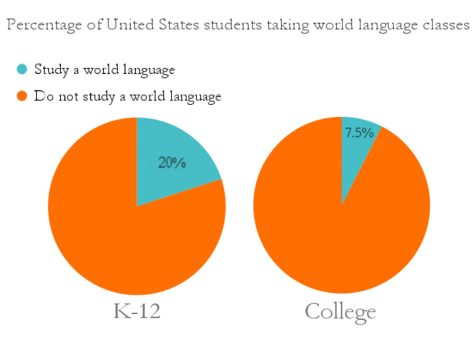The value of world language classes to careers and community
Proficiency in a second language not only provides an advantage when seeking careers, but also fosters cultural acceptance.
In the United States, only 20 percent of students in Kindergarten through twelfth grade study a world language. As for United States college students, only 7.5 percent take language classes, according to amacad.org. Without language education, scholars lack the ability to communicate interlingually, which is essential in modern careers. World language classes provide an opportunity for students to gain openness towards non-English-speaking members of their local communities. Therefore, schools should include world language classes among core curricular classes.
Some argue that foreign language should not be an essential academic course in the United States, asserting that students should focus on subjects they will supposedly encounter more in their future careers, such as English, mathematics, and science. New York State eliminated Regents exams in foreign languages to reduce costs in 2011, according to The New York Times.
However, proficiency in a language other than English is becoming increasingly more valuable in the modern world. The international and intercultural connectivity of today’s world favors those who can communicate across language barriers. Seventy-five percent of people in the world do not speak English, according to amacad.org. As a result, the ability to speak a second language is attractive to employers, according to leadwithlanguages.org. Experience with a world language is beneficial, and sometimes even essential, in careers ranging across business, healthcare, public policy, marketing, technology, and communications. Those able to speak languages in addition to English have the advantage of forming relationships and interlingual connections.

Even within the United States, linguistic diversity abounds. One in five Americans speaks a non-English language at home, according to cal.org. It is probable that students will encounter situations in which interlingual communication is necessary. World language classes allow students to prepare and gain expertise in their future professional endeavors. As today’s students are tomorrow’s workers and leaders, the presence of world language among the core curricular classes is crucial.
In addition to career benefits, student knowledge of non-English languages unites communities. Research shows that students studying a non-English language gain an awareness of and openness towards people with different cultural and linguistic backgrounds, according to actfl.org. Having studied Spanish myself since elementary school, I notice that Hispanic culture captivates me, especially as I have gotten older. I wonder about differences in the lifestyles of those who speak Spanish and those who speak English within my own locality.

Language unites people. It is how humans express feelings, ideas, and realities. Although the United States does not have an official language, Americans still coin non-English languages “foreign.” However, more than 67 million United States residents speak non-English languages at home, according to cis.org. My study of Spanish, a prominent language in my locality, gives me a mode of expression in common with more of my community. It allows me to empathize and form connections with people from whom I would otherwise be distant. My study of a “foreign” language makes me less foreign from Spanish-speaking members of my community.
Students with the opportunity to study a world language should understand the value a second language brings. Proficiency in a second language provides an advantage when seeking careers, as the globalized world requires interlingual communication. World language classes are necessary in modern education because they provide students with long-term benefits and skills.
Featured Image by Avery Kim ’24

Avery is honored to serve as one of the Editors-in-Chief of the King Street Chronicle. After two years on the newspaper’s staff, she has learned countless...











Mme Williams • Apr 24, 2022 at 7:08 pm
Great, well researched and expertly written article, Avery. Thanks for sharing your love of language learning, and explaining its importance.
Christine • Mar 1, 2022 at 12:37 pm
Beautifully written! Wow, what a great article. Bravo, Avery!
Lindsay Taylor • Feb 11, 2022 at 1:48 pm
Great job, Avery! Your article was thoughtful and well-written as always!